Survey of Youth and Young Adults on Vocations: Part 1 - Respondent Characteristics
Consideration of Priesthood and Religious Life Among Never-Married U.S. Catholics by the Center for Applied Research in the Apostolate at Georgetown University - Washington, D.C.
Part I. Respondent Characteristics
This section of the report describes the demographics, background, and religiosity of respondents. For each question highlighting subgroup differences that are apparent in the data, such as gender, race and ethnicity, and/or age. Later in this report, these characteristics are used to predict which respondents are more likely to have considered a vocation.
Types of Respondents
Nearly six in ten male respondents (59 percent) are adults. Other respondents, totaling 41 percent, are teens between the ages of 14 and 17. The racial and ethnic distribution of adult male respondents is different than that of younger respondents. Among adults, non-Hispanic white males make up a majority (62 percent). This is not the case among teens, where 51 percent of respondents are either Hispanic (38 percent) or some other race and ethnicity (13 percent).
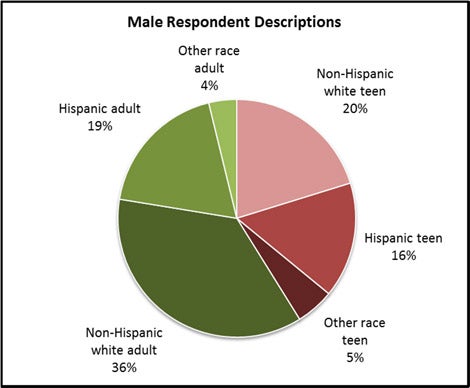
Nearly seven in ten female respondents (69 percent) are adults. Other respondents, totaling 31 percent, include teens between the ages of 14 and 17. The racial and ethnic distribution of adult female respondents is different than that of younger respondents. Among adults, non-Hispanic white females make up a majority (69 percent). This is not the case among teens, where 38 percent of respondents are either Hispanic (31 percent) or some other race and ethnicity (8 percent).
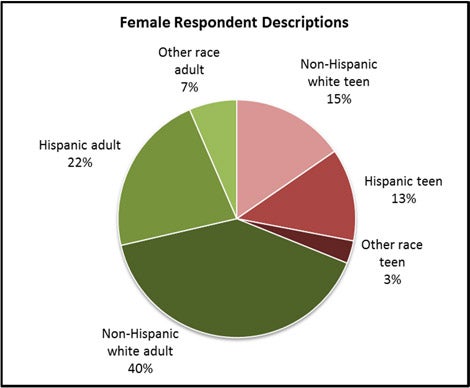
Age
The average age among male respondents is 26 and 28 for female respondents. The average age of teen respondents are all very similar given the specific over-sampling of those ages 14 to 17. Among adults, the average ages by race and ethnicity and gender are generally in the thirties. These ages capture the segment of the population that is most often considering or discerning a vocation within the Church.26
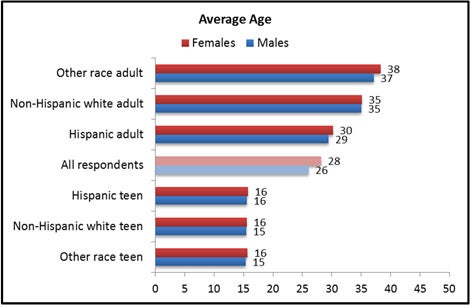
Overall, 80 percent of male respondents and 74 percent of female respondents are members of the Millennial Generation. This generation, born in 1982 or later (up to 1993 among adults), have come of age primarily under the papacies of John Paul II and Benedict XVI. Because some still live with their parents, their religious practice is often closely related to that of their families of origin.
Number of Siblings and Birth Order
Overall, 6 percent of respondents have no siblings. The largest number of siblings reported in the survey is 13. Many respondents say they have either one or two siblings.
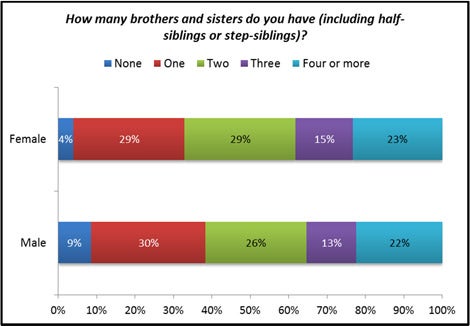
Hispanic adults are the most likely to indicate that they have four or more siblings (41 percent). By comparison, only 16 percent of non-Hispanic white adults and 25 percent of those of other races and ethnicities have this many siblings.
Respondents are fairly equal distribution of respondents in each birth order position of eldest, middle, and youngest child. Male respondents are slightly more likely to be an only child.
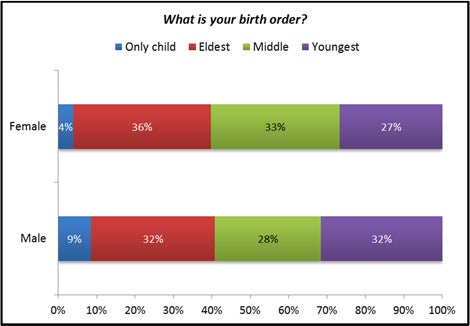
Entry into the Church
Most male and female never-married Catholics entered the Church through infant baptism. Small percentages were baptized as children and even fewer in their teens and 20s.
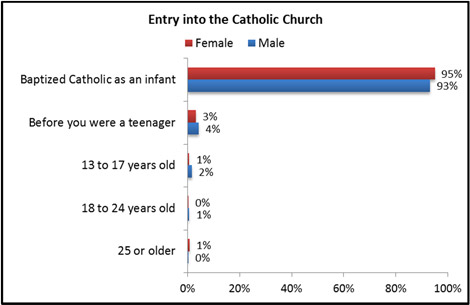
Respondents who are neither Hispanic nor non-Hispanic white are more likely to have entered the Church after infancy (not shown in figure above). This is consistent among male and female respondents. Most of these respondents indicate that they were baptized as children.
Among the small numbers of never-married Catholics who entered the faith as adults, 57 percent of male respondents and 63 percent of female respondents noted that they completed a Rite of Christian Initiation of Adults (RCIA) program.
Among those who became Catholic as adults, most say they were formerly affiliated with a Protestant denomination (47 percent). However, about one in four (27 percent) indicate they previously had no religious affiliation. Seven percent say they were an Orthodox Christian and 20 percent indicated affiliation with some other faith.
Catholic Education
Overall, nearly two-thirds of respondents (64 percent) have never attended Catholic educational institutions. Among the U.S. adult Catholic population only 48 percent report this.27 The disparity here is due to the relative youth of the never-married sample. Older generations of Catholics were much more likely than Millennials to attend Catholic schools.
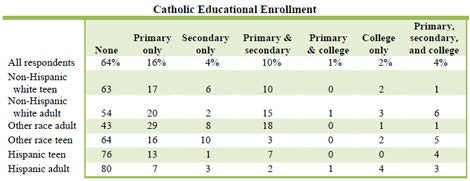
Hispanic adults are among the most likely to report never attending a Catholic educational institution (80 percent). Adult respondents who are neither Hispanic nor non-Hispanic white are the least likely to indicate this (43 percent).
Overall, 4 percent of respondents have attended Catholic primary school, secondary school, and college.28
Female respondents are slightly more likely than males to report enrollment in a Catholic educational institution at some point (not shown in the table above; 38 percent compared to 34 percent). This difference, however, is not statistically significant.
As the figure on the next page shows, among those who attended a Catholic educational institution the average total length of enrollment is 7.8 years. This is highest among non-Hispanic white adults (8.6 years) and lowest among Hispanic adults (6.3 years).
The average number of years enrolled among Hispanic teens is also comparatively lower than the average length of enrollment for non-Hispanic white teens. Thus, not only are Hispanic respondents less likely to be enrolled in a Catholic school, but among those who are enrolled, the length of their enrollment is shorter, on average, than other students.
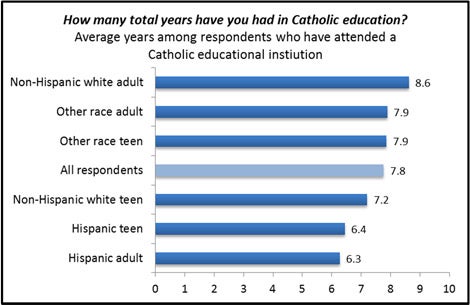
Parish-based Religious Education
Overall, 58 percent of respondents indicate they attended a parish-based religious education program at some point. This is least common among Hispanic adults (48 percent) and most common among non-Hispanic white teens (65 percent).
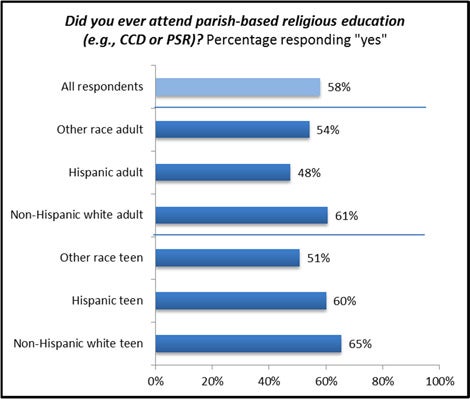
Generally female respondents are slightly more likely than male respondents to have attended parish-based religious education (not shown in the figure above; 61 percent compared to 55 percent).
Among those who have attended parish-based religious education, non-Hispanic white respondents are most likely to report being in these programs for a longer period of time. Hispanic respondents report the shortest periods of attendance, on average.
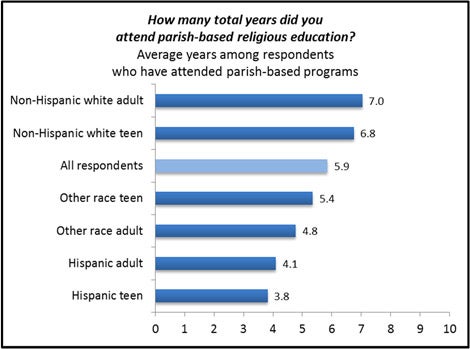
Parish Youth and Young Adult Groups
Overall, 16 percent of respondents say they participated in parish youth groups during elementary or middle school years and 14 percent participated in these during high school years. Seven percent of non-Hispanic white adults say they participated in a parish young adult group compared to 3 percent of Hispanic adults, and 14 percent of adults of some other race. Non-Hispanic white adult respondents are most likely to report participation in a campus ministry group during college.
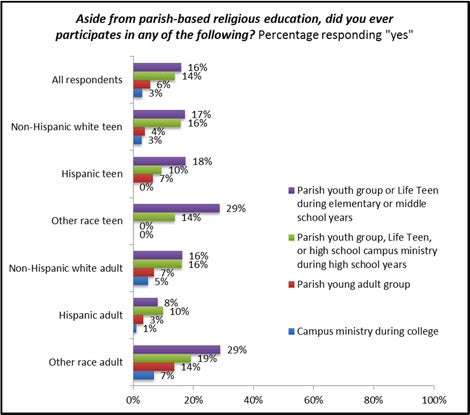
Regardless of race and ethnicity, female respondents are generally more likely than males to say they participated in any of these groups (not shown in figure above).
Childhood Sacraments
Female respondents are slightly more likely than male respondents to report having celebrated First Communion (89 percent compared to 85 percent) or Confirmation (77 percent compared to 71 percent).
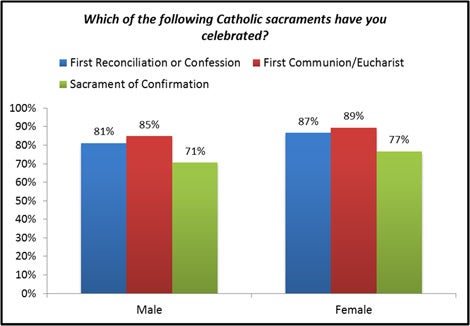
Female teens are significantly more likely than male teens to indicate celebration of their First Communion (93 percent compared to 75 percent) or Confirmation (69 percent compared to 55 percent).
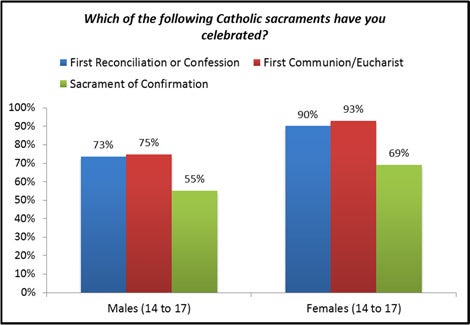
Non-Hispanic white respondents are more likely than Hispanic respondents and those of other races and ethnicities to say they have celebrated each sacrament.
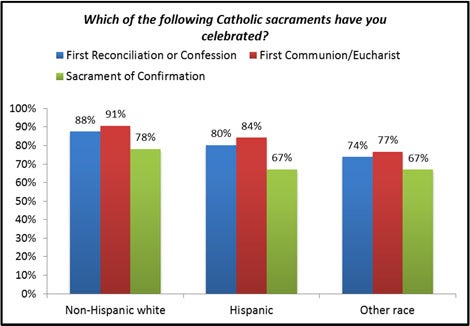
Highest Level of Education
Among adult respondents, Hispanic men and women are less likely than those of other races and ethnicities to indicate having a bachelor’s degree. A quarter of Hispanic males do not have a high school diploma or equivalent. Nearly one in five female Hispanics (18 percent) indicate the same.
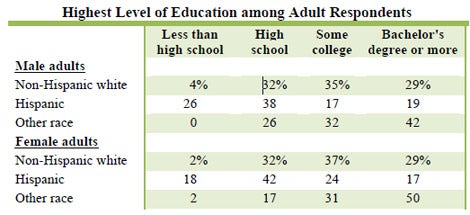
Among non-Hispanic white adults, two-thirds (64 percent) of males and females (66 percent) have attended college. Among those of other races, the percentage having attended college are even higher (74 percent of males and 81 percent of females).
A majority of Hispanic adults—both male and female—have not attended any college. College enrollment is often a prerequisite for pursuing a religious vocation.
Importance of Faith during High School
Nearly a quarter of male respondents (24 percent) and a fifth of female respondents (21 percent) say their faith was “among the most important” or was the “most important” part of their life while they were in high school.
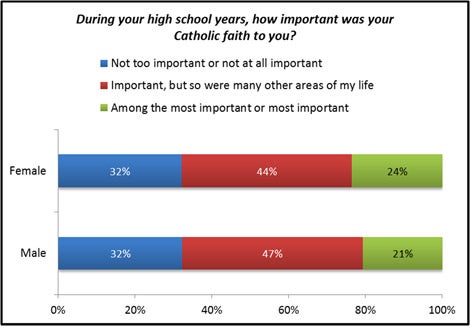
Sixteen percent of Hispanic teens say their faith was “among the most important” or was the “most important” part of their life while they were in high school (likely representing their current opinion given their age). By comparison, 39 percent of adult respondents of other races and ethnicities responded as such (not shown in the figure above).
Current Importance of Faith
A third of female respondents and about a quarter of male respondents say their faith is currently “among the most important” or is the “most important” part of their daily life.
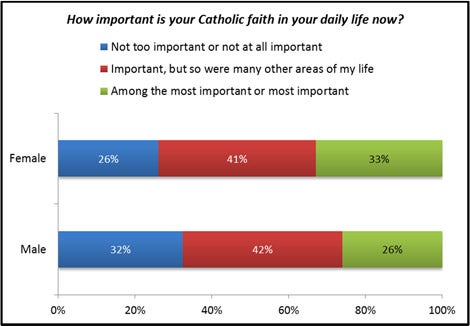
A majority of Hispanic adult females (not shown in figure above; 54 percent) say that their religion is “among the most important” or is the “most important” part of their daily life (not shown in the figure above). Non-Hispanic white teen males are among the least likely to respond similarly (19 percent).
Parental Discussions of Faith during High School Years
A quarter of female respondents indicate that their parents discussed religion with them at least once a week when they were in high school. Male respondents are more likely to report having discussions of this frequency (31 percent). About half of male (48 percent) and female (49 percent) respondents indicate that their parents rarely or never discussed religion with them during their high school years.
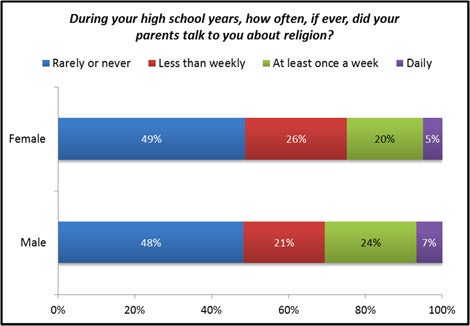
There are significant differences among female respondents by race and ethnicity. Female Hispanic adults and teens are more likely than female respondents of other races and ethnicities to say they discussed religion with their parents at least once a week during their high school years.
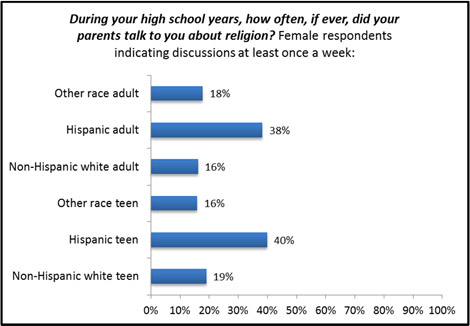
Frequency of Mass Attendance during High School
A quarter of female respondents and 27 percent of male respondents say they attended Mass weekly during their high school years.
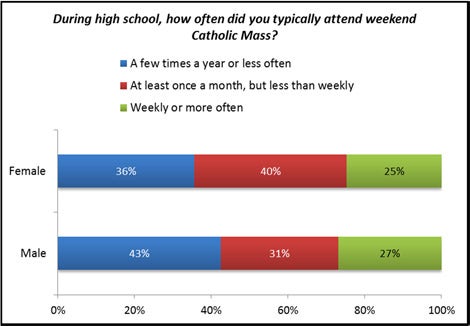
Non-Hispanic white adults are among the most likely to indicate they attended Mass weekly during high school (not shown in the figure above; 34 percent). Nineteen percent of Hispanic respondents report weekly attendance in high school as do 21 percent of those of other races and ethnicities.
Just more than one in five never-married Catholics attend Mass every week (23 percent of females and 21 percent of males). Majorities say they only attend a few times a year or less often (54 percent of females and 60 percent of males).
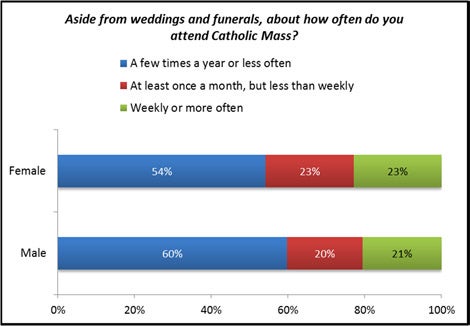
These levels of Mass attendance are a bit dissimilar from the adult Catholic population in general where 24 percent attend weekly, 25 percent attend less than weekly, but at least once a month, and 51 percent attend a few times a year or less often.29
These differences are primarily related to life-cycle Mass attendance effects. Never-married Catholics are disproportionately of the Millennial Generation, which currently has lower levels of Mass attendance than older generations. As the figure on the next page shows, 42 percent of Catholic teens say they attend Mass at least once a month. This drops to 38 percent among those age 18 to 24 and 35 percent among those age 25 to 34. Mass attendance then increases among older never-married Catholics. This pattern is well known and is related to young Catholics going to Mass with their parents as teens and then becoming less likely to do so as they become adults and live on their own. Mass attendance then increases again as Catholics age.30
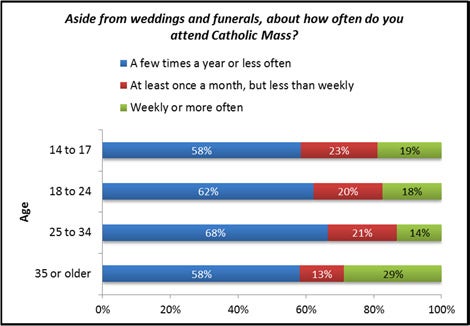
There are not statistically significant differences in frequency of Mass attendance by race and ethnicity.
At the same time, among adult never-married Catholics, self-reported Mass attendance during high school is a fairly good indicator of a respondent’s current frequency of Mass attendance. For example, as shown in the figure below, among those who rarely or never attended Mass during high school, 83 percent rarely or never attend now. Among those who likely attended at Christmas and Easter in high school, 60 percent indicate attending Mass on a few times a year now. A majority (54 percent) of those who attended weekly or more often during high school, attends Mass this frequently now.
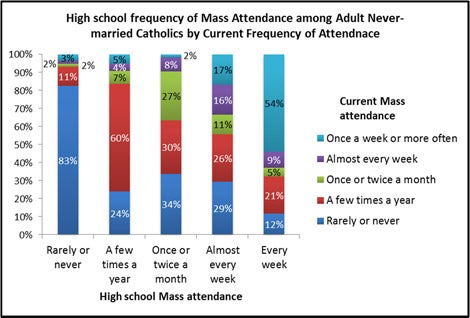
Parish Registration
Six in ten respondents indicate that they or their family is registered with a Catholic parish. This is most common among non-Hispanic white teens (84 percent) and least common among Hispanic adults (40 percent).
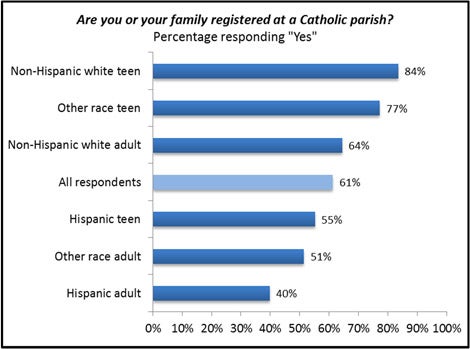
Overall, 57 percent of respondents who are registered with a parish say they “regularly attend Mass” at the parish they are registered with. This is least often noted among non-Hispanic white adults (48 percent) and is most common among Hispanic teens (72 percent) and teens of other races and ethnicities (77 percent).
Prayer and Devotional Practices and Groups
Most respondents, 68 percent, say that they do not regularly participate in any of the prayer and devotional practices or groups listed. Hispanic respondents are the least likely to say they do not regularly participate in these (54 percent of adults and 46 percent of teens). Non-Hispanic white adults and teens of other races and ethnicities are among the most likely to say they do not regularly participate in these (80 percent and 88 percent, respectively). Hispanic respondents are more likely to report participation in quinceañera than anything else listed. Overall, respondents are most likely to indicate regular participation in religious retreats (12 percent) and popular devotions (11 percent).

Participation in Ministries
Overall, 15 percent of respondents have been altar servers (18 percent of males and 11 percent of females). One in five non-Hispanic white adults and teens has served as an altar server. Fewer Hispanic respondents and those of other races and ethnicities indicate that they have been altar servers. About one in 20 respondents, overall, has served as a lector (6 percent), usher or minister of hospitality (6 percent), minister of Holy Communion (5 percent), cantor or music minister (5 percent), or catechist (5 percent).
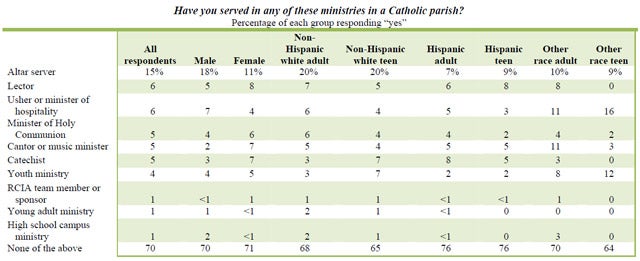
Seven in ten respondents indicate that they never served in any of the ministries listed. Few indicate having served in youth ministry (4 percent), young adult ministry (1 percent), high school campus ministry (1 percent), or as a RCIA team member or sponsor (1 percent).
Among those who have not been involved in ministries (i.e., those listed in the previous table), Non-Hispanic white respondents—both teens (12 percent) and adults (8 percent)—are the least likely to say they would be interested in serving in these in the future. Overall, 14 percent of respondents who have not been involved in ministry say they would be interested in being involved in the future.
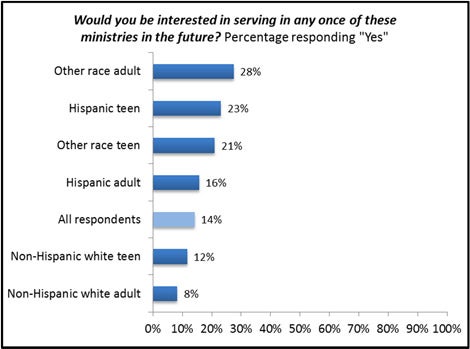
Participation in World Youth Day and
National Catholic Youth Conference
Overall, 7 percent of respondents indicate that they have participated in the Catholic Church’s World Youth Day and 4 percent have participated in the National Catholic Youth Conference. World Youth Day participation is highest among Hispanic respondents and other race teens. Other race teens and adults are among the most likely, along with Hispanic adults, to say they have participated in meetings of the National Catholic Youth Conference.
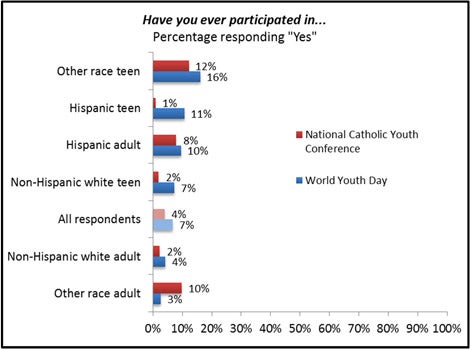
There are no significant differences by gender in respondents’ reported participation in World Youth Day or the National Catholic Youth Conference.
Service Volunteering
About half of respondents (49 percent) say they have volunteered to be part of a service project that helped people in need. This was most often reported by non-Hispanic white teens (68 percent) and teens of other races (66 percent). This is least often reported by Hispanic adults (33 percent) and non-Hispanic white adults (45 percent).
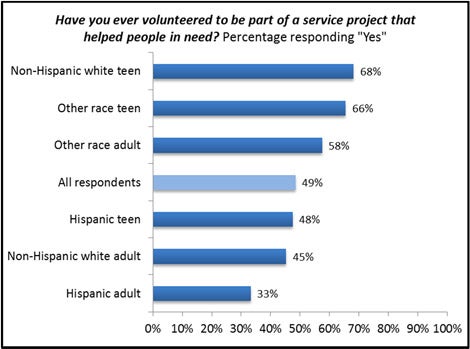
Adults are generally less likely than teens to report being part of a service project. This may be related to these individuals coming of age before a time when this became a requirement in many schools in the 1990s.
There are few gender differences (not shown in the figure above). The only one of statistical significance is that Hispanic adult females are more likely than Hispanic adult males to report that they have been a part of a service project (40 percent compared to 27 percent).
Respondents who reported taking part in these projects were asked where this service was done. Eighty-eight percent report that this project was done in their community. Twenty-two percent indicate they have been part of a service project outside of their community but still within the United States. Non-Hispanic white adults are among the most likely to report this (43 percent). Only 4 percent report involvement in a service project outside of the United States.
As shown in the figure on the next page, among respondents who have not volunteered, nearly four in ten (37 percent) say they have considered taking part in a service project to help people in need. This is most common among other race respondents—both teens and adults.
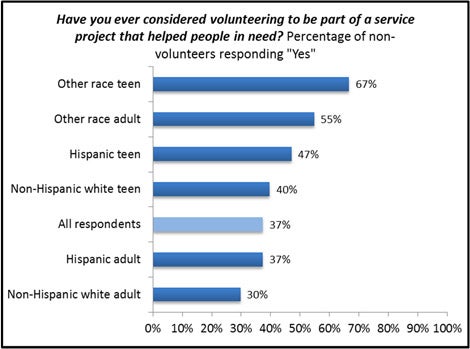
Non-Hispanic white adults who have never been a part of a service project are least likely to say they have considered this (30 percent).
What it means to be Catholic
Respondents were provided a list of items and asked “How important are the following factors to your sense of what it means to be a Catholic?” Overall respondents were most likely to say helping the poor (42 percent) and receiving the Eucharist (41 percent) were “very important” to their sense of what it means to be Catholic. Protecting life (34 percent), attending Sunday Mass each week (32 percent), and having devotion to Mary (32 percent) were also among the most commonly selected as “very important.”
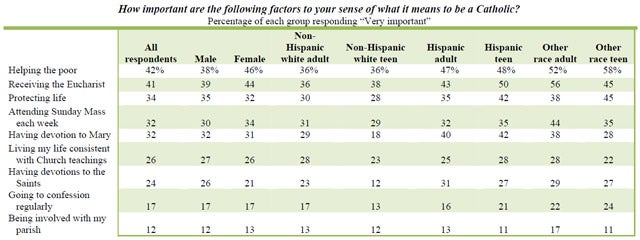
The aspects that respondents were least likely to select as “very important” were going to confession regularly (17 percent) and being involved in their parish (12 percent). Thus, although most respondents are likely to say receiving the Eucharist and attending Mass is at least “somewhat” important to their sense of what it means to be Catholic—active participation and involvement in their parish beyond this is not as essential.
Non-Hispanic white adults (36 percent) and teens (36 percent) are significantly less likely than respondents of other races and ethnicities to say helping the poor and receiving the Eucharist are “very important” to their sense of what it means to be Catholic.
Belief in the Real Presence
Overall, six in ten respondents (60 percent) say they believe Jesus Christ is really present in the bread and wine of the Eucharist. Four in ten (40 percent) say they believe the bread and wine are symbols of Jesus, but Jesus is not really present. Non-Hispanic white respondents are slightly less likely than those of other races and ethnicities to believe in the Real Presence.
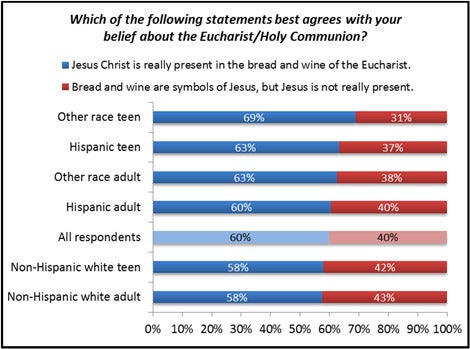
There are few significant gender differences (not shown in the figure above). One of note, Hispanic female teens are more likely than Hispanic teen males to believe in the Real Presence (75 percent compared to 52 percent).
Description of God
Overall, two-thirds of respondents (66 percent) say a description of God as “a positive influence in the world” is closest to their own point of view. This point of view is consistent among subgroups with little variation. Hispanic and other race adults are slightly more likely than others to say a conception of God as “a cosmic force that set the laws of nature in motion that stands apart from the world he created” comes closest to their own point of view (12 percent and 13 percent, respectively).
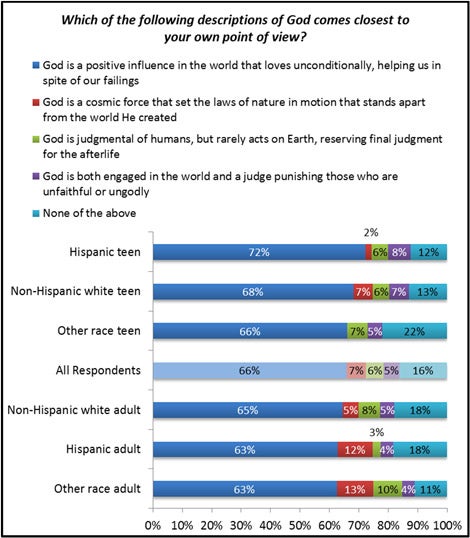
Respondents were also asked about their point of view on the possibility of having a personal relationship with God. Overall, seven in ten (70 percent) say that “God is one with whom people can have a personal relationship” comes closest to their own point of view. Thirteen percent feel that “God is an impersonal force.” Seventeen percent say that neither of these statements comes closest to their own point of view. There are few differences of note among subgroups.
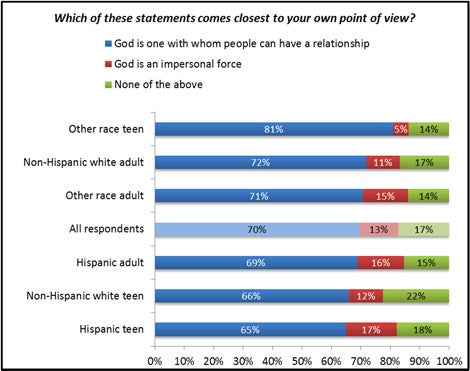
Importance of Prayer
Overall, 28 percent of respondents say prayer is among the most important parts of their life. Another 40 percent say it is important but so are many other areas of their life. About a third (32 percent) say this is either not too important or not important at all.
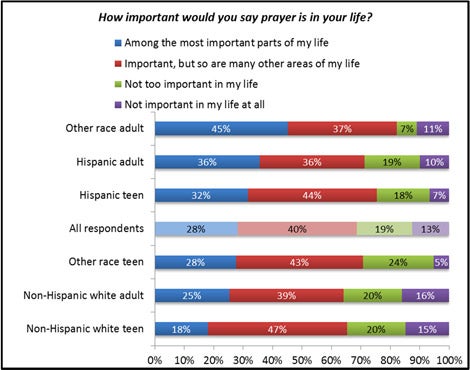
Female respondents are more likely than male respondents to say prayer is important to them (74 percent compared to 64 percent responding “among the most important” or “important, but so are many other areas of my life”).
Praying the Rosary
Overall, 44 percent of respondents report that they pray the rosary.31 This is least common among non-Hispanic white respondents (36 percent of teens and 32 percent of adults). By comparison, 63 percent of Hispanic adults say they pray the rosary.
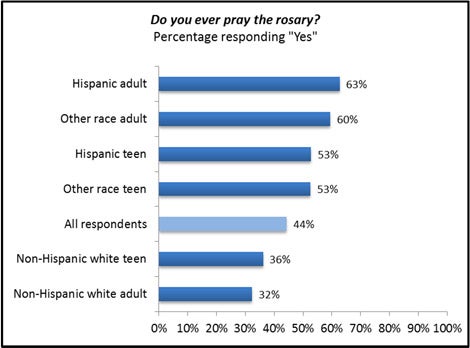
Female respondents are more likely than male respondents to say they pray the rosary (not shown in the figure above; 48 percent compared to 41 percent).
Among respondents who pray the rosary, 6 percent say they do so every day and an additional 7 percent do so less than daily, but at least once a week. Twenty-two percent pray the rosary less than weekly but at least once a month. Most, 47 percent say they do so a few times a year. Nearly one in five (18 percent) say they do so less than yearly.
Among these respondents who say the rosary, there are no significant differences by gender or race and ethnicity related to frequency of prayer.
As the figure on the next page shows, respondents who pray the rosary most often do so alone (52 percent). One in four recite this prayer this with family (25 percent) and 23 percent do so within a group.
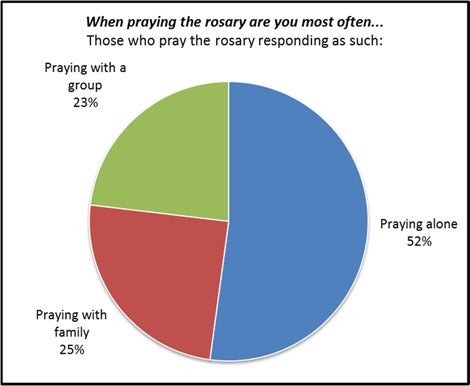
Hispanic adults and teens are among the most likely to pray the rosary with family (not shown in the figure above; 37 percent and 34 percent, respectively). Non-Hispanic white adults are least likely to report this (4 percent).
Mass Attendance on Feast Days Devoted to Mary
Overall, 42 percent of respondents say they would be “somewhat” or “very” likely to attend Mass on a feast day for Mary in the next year. Hispanic teens and adults are the most likely to indicate this (62 percent and 57 percent, respectively). Non-Hispanic white teens and adults are the least likely to say they would attend (33 percent and 31 percent, respectively).
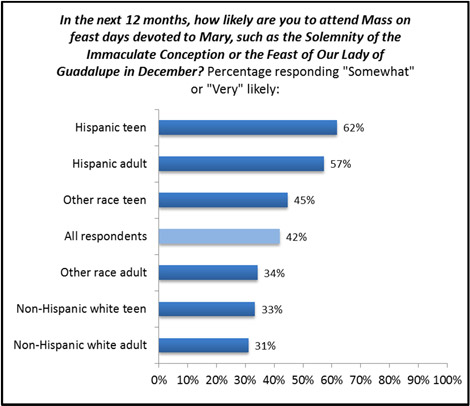
Female respondents are slightly more likely than male respondents to indicate they will likely attend Mass on a feast day for Mary (not shown in the figure above; 45 percent compared to 39 percent).
As shown in the figure below, Hispanic teens and adults who are at least “a little” likely to attend Mass on a feast day devoted to Mary are the most likely to say this feast day is associated with their nationality or ethnicity (53 percent and 63 percent, respectively).
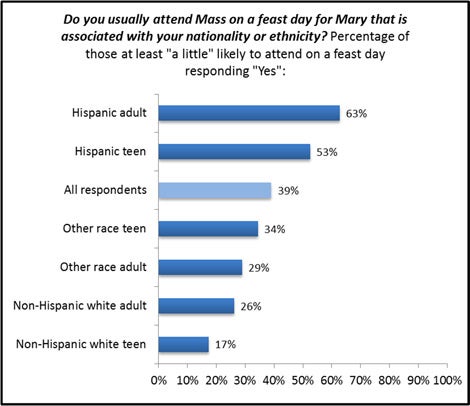
Respondents were also asked if they belong to any groups or organizations that encourage devotion to Mary. Overall, 5 percent of respondents indicated they do belong to such a group. There are no statistically significant differences among respondents by age, gender, race, or ethnicity for this question.
Reading and Praying with Scripture
Reading the Bible or praying with Scripture outside of Mass is relatively uncommon among never-married Catholics. Eighty-two percent report that they do so only a few times a year or less often. One in ten (10 percent) report that they do so at least once a month and 5 percent do so at least once a week. Only 4 percent say they read the Bible or pray with Scripture every day.
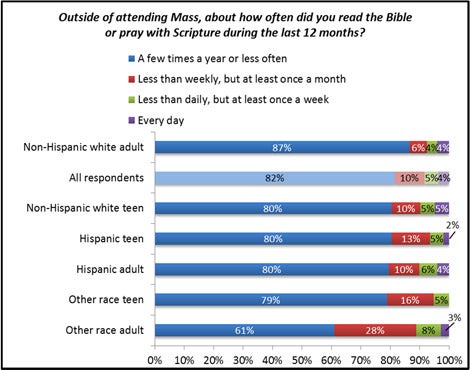
Non-Hispanic white adults are the least likely to read the Bible or pray with Scripture outside of Mass (13 percent). Other race adults are the most likely to say they do this (39 percent at least once a month).
There are no statistically significant differences for this question related to gender.
Religious or Spiritual Media Use
Respondents were asked about their religious or spiritual media use. The results for these questions are shown in the next four figures. The first of these includes “traditional media” (e.g., television, radio, print).
Adult Hispanics and adults of other races are most likely to say they have watched religious or spiritual content on television in the last year (29 percent and 38 percent, respectively). This is least common among Non-Hispanic white adults (17 percent) and other race teens (19 percent).

Generally, respondents were most likely to say they watch religious or spiritual content on television. They are more likely to do that than to read a print copy of a religious or spiritual magazine or newspaper, or a print copy of a religious book. Fewer listen to religious or spiritual content on radio. Very few have purchased a print copy of a religious or spiritual book in the last year.
Generally, respondents are even less likely to use new media than traditional media to access religious or spiritual content. This is consistent with previous survey results for the overall Catholic population and the Catholic Millennial Generation more specifically.32
As with traditional media, video is the number one draw with about one in ten respondents overall (not shown in table below; 8 percent) indicating that they have watched a religious or spiritual video online in the last 12 months. This is most common among non-Hispanic white and other race teens (10 percent and 14 percent, respectively).
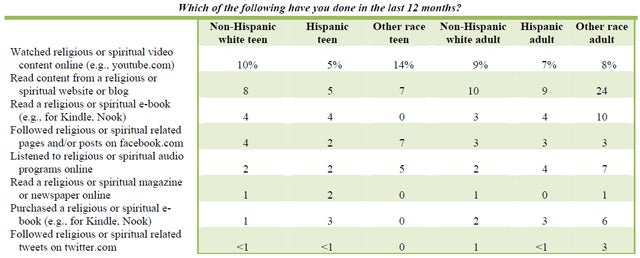
It is not that these Catholics are not using new media or social networking and sharing sites. It is instead that few are doing so to access or share religious or spiritual content.
More specifically, respondents overall are most likely to indicate that they have visited a website for a Catholic parish (not shown in the table below; 11 percent) or school, college, or seminary (9 percent) than have used mainstream new media to access or share religious or spiritual content. This represents a more utilitarian use of the internet—most likely accessing Church sites for information they need (i.e., sacramental information, Mass times, school schedules). Again, this is consistent with the overall Catholic population.33

Very few, just 1 percent of respondents overall (not shown in table above) indicate they have ever visited a website about vocations.34
A majority of respondents (57 percent; not shown in figure below) have not used any of the media listed in the previous tables to access religious or spiritual content. Other race adults are an outlier and are much more likely to indicate having used at least one type of the media listed (70 percent).
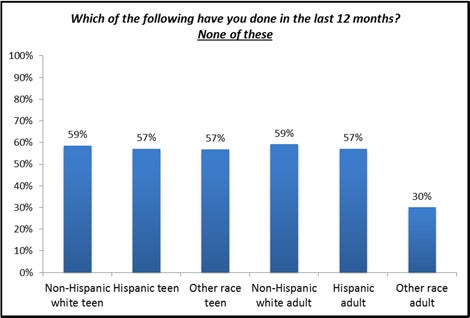
Although there are few gender differences for any specific type of media, female respondents are slightly less likely than male respondents, overall, to say they have used none of the media listed in the last year (54 percent compared to 60 percent).
Parent Prepared for a Vocation
Very few respondents indicate that their mother or father prepared for a vocation within the Church before becoming a parent. Hispanic teens are most likely to indicate their father prepared to be a priest or brother (4 percent). Non-Hispanic white adults are most likely to indicate their mother prepared to become a religious sister (4 percent). However, the differences reported here and in the figure below are all within margin of error.
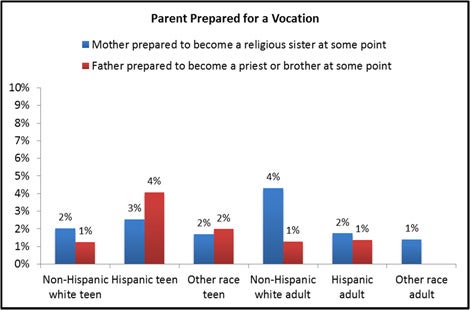
Having Known Catholic Clergy, Seminarians, or Vowed Religious as a Child or Teenager
Knowing someone who was a priest, seminarian, religious brother, or religious sister within one’s family (e.g., uncle, aunt, sibling, or cousin) is relatively uncommon. One in ten (not shown in the table below; 10 percent) reported having a religious sister in their extended family and 7 percent reported having a priest in the family. Non-Hispanic white teens are most likely to indicate a priest in their family (11 percent) and Hispanic teens are most likely to indicate a religious sister (13 percent).
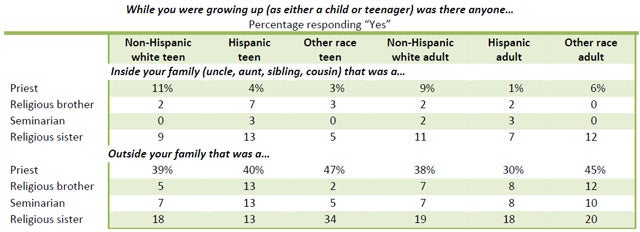
Respondents were much more likely to indicate they knew a priest, seminarian, religious brother, or religious sister outside of their extended family when they were growing up. Other race teens and adults are most likely to indicate knowing a priest (47 percent and 45 percent, respectively) and other race teens are most likely to say they knew a religious sister (34 percent).
Knowing a religious brother or seminarian within one’s family or outside of it is relatively uncommon.
Encouraging Vocations in Others
Few respondents indicate that they have ever encouraged some they know to become a priest (5 percent), religious brother (3 percent), or religious sister (3 percent).
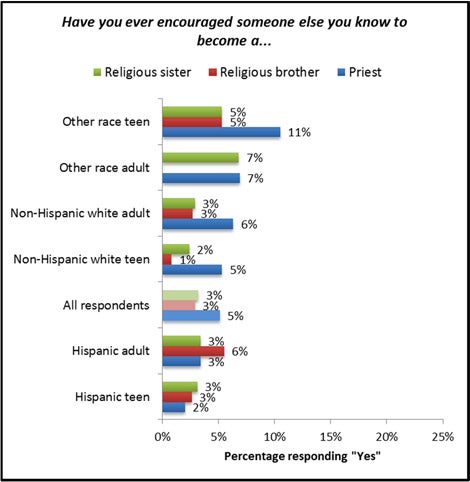
Other race teens are most likely to indicate they have encouraged someone to become a priest (11 percent). Six percent of Hispanic adults have encouraged someone to become a religious brother and 5 percent of other race teens have encouraged someone to become a religious sister.
Respondents who indicated that they had never encouraged someone to become a priest, religious brother, or religious sister were asked if they ever would encourage someone for these vocations. Overall, about one in five said they would, with non-Hispanic white adults and teens being more likely, relative to others, to indicate that they would do so.
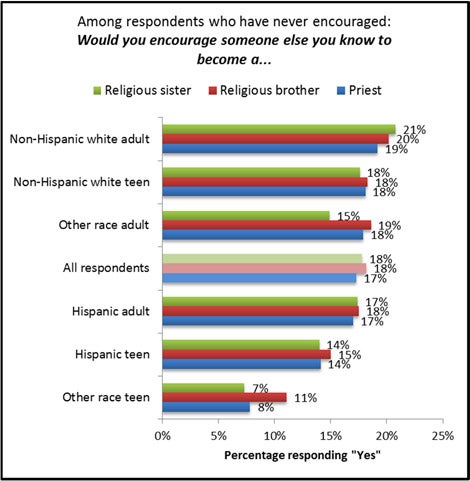
Among respondents who indicated they have encouraged someone they know to become a priest, religious brother, or religious sister many indicate they would encourage someone in their family to seek one of these vocations. Two thirds or more say they would also encourage a family member to become a priest (73 percent), religious brother (67 percent), or religious sister (66 percent). Hispanic respondents (teens and adults) are generally among the most likely to say they would encourage someone in their family towards one of these vocations whereas other race teens are among the least likely to indicate this.
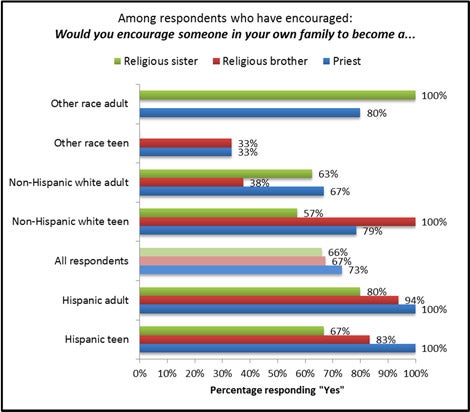
Reasons for Not Wanting to Encourage Vocations
Respondents who indicated they would not encourage someone to seek a vocation were asked in an open-ended question, “Why wouldn’t you encourage someone for this vocation(s)?” Responses were classified by the type of comments made and are displayed in the table below.
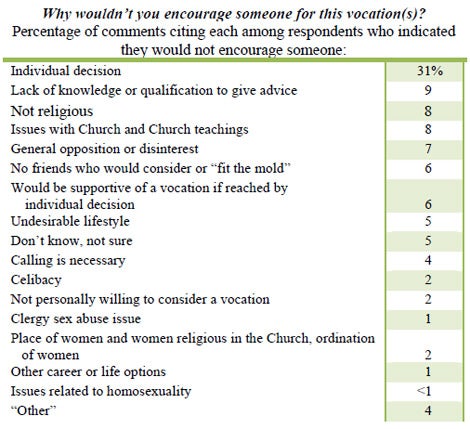
“It’s not my place to encourage”
By far the most common reasons cited was that it is the individual decision of other people they know and that they don’t feel that it is their place to encourage or offer advice (31 percent). Some say they feel that the person would have to have a calling before they offer encouragement (4 percent). The second most common reason given was that the respondent does not have enough knowledge or feel qualified to offer this type of encouragement or advice to others. Together these reasons account for more than four in ten of the comments (44 percent) made. Some of those making these comments also note that they don’t feel it’s their place to encourage but that they would be supportive of someone who was interested in a vocation (6 percent of comments). Representative examples of these types of comments are shown below:
- That is a decision that each person should make on their own. It is life changing in the utmost way and needs to come about as the result of a deep personal reflection and not be influenced at all by outside input.
- Not my place to. It is up to the individual if they are considering it and ask my opinion I would give it.
- People make their own choices in life. If somebody I knew was thinking about it I would be supportive.
- Porque eso lo siente uno dentro de uno.
- It's not my place to tell them what to become.
- Vocation is a personal choice. I do not want to interfere with personal choices.
- It's not the career choice they want so I won't push it on them.
- I believe it's something you have to find for yourself. That said, if a friend or relative offered that they were considering a vocation, I would not discourage them.
- I feel it is their decision and if they have questions they should speak to someone who has the vocation.
- Don’t like to control people’s life paths.
- It is not my place. Each person should discern their own calling.
- Not my place. They can make their own decisions.
- If it is their calling, they will know.
Issues with the Church or lack of religiosity
Eight percent of respondents indicated they would not encourage because they have issues with the Church or Church teachings. Some of these comments also reference celibacy (2 percent), the respondent’s view of the place of women and women in the Church or a preference for the ordination of women (2 percent), and issues related to homosexuality (less than 1 percent). Eight percent don’t feel they are religious enough to provide encouragement. Representative comments include:
- Not my place. I don't hold my faith that dearly so I shouldn't advise anyone on that decision.
- I have too many issues with the church.
- Because I feel the Catholic religion needs to change allowing religious people to get married.
- Sexist. If women can't have the role, then I should not encourage a male to have the role. Plus, the hierarchy of the church socialized and/or brain washes the men. Major change is needed!
- The continued sex discrimination within the church (women prohibited from becoming priests, priests taking over control of leadership of the nuns).
- The lack of respect and power for women in the Church. The option for all religious to be able to marry should they wish.
- Don't agree with teachings.
- Because I don't think nuns are respected enough by the Church.
- Porque primero que nada yo deberia estar mas involucrada en la fe Cristiana.
- They cannot marry.
- Because I believe the Catholic Church is sexist, elitist and not at all what Jesus intended at this point in history.
- Because the good they can do is limited by the Hierarchy's obsession with birth control and abortion to the exclusion of care for the poor and peace work. People wanting to do Christ's work in the world can do more with non-sectarian organizations such as Doctors Without Borders.
- They would be forced into preaching beliefs of the Church that I don't agree with from birth control to no gay marriage.
“I don’t know anyone who should be encouraged”
Some say the people they know would not fit the mold of a religious vocation (6 percent). Representative comments include:
- Don't know of anyone seeking.
- I don't know anyone that would be fit for that life.
- I just don't know anyone that I would encourage. Seems like the kind of things that you don't talk about and just support the person.
- I don't know anyone who would be good at this vocation.
- No one I know will fit the personality of holding the vocation of becoming a priest.
- I don't have a whole lot of friends and it has nothing to do with finances so it's not tops on my mind.
- It’s not really something that I think about or that comes up often. I've never had the opportunity of someone saying that they wanted or were thinking of pursing a vocation seriously.
- No one has ever expressed interest around me to do that.
- I don’t know of anyone that I could see being a priest, religious brother or religious sister.
Seven percent just indicate general disinterest in encouraging vocation (e.g.,“not interested”). Five percent feel this is an undesirable lifestyle that they cannot recommend to others. Fiver percent aren’t sure or don’t know why they would encourage someone. Two percent are not willing to consider a vocation themselves and thus feel they cannot encourage others to do so. One percent note clergy sex abuse. One percent indicates they encourage people to have other career goals or life options instead. Four percent of comments could not be classified in any of these categories.
Footnotes
- The average age of U.S. ordinands in 2012 was 35, with the oldest being age 66 (Source: CARA/USCCB: The Class of 2012:Survey of Ordinands to the Priesthood). The average age of religious women professing perpetual vows in 2011 was 40, with the oldest being age 71 (Source: CARA/USCCB: New Sisters and Brothers in Perpetual Vows).
- CARA. Catholic Media Use in the United States, 2011. Available online at: https://catholicpress.site-ym.com/resource/resmgr/docs/print_study_final_report.pdf
- Note some of the teens report Catholic college attendance. Some start college at the age of 17 or enroll in college classes while attending high school.
- CARA. Catholic Media Use in the United States, 2011. Available online at: https://catholicpress.site-ym.com/resource/resmgr/docs/print_study_final_report.pdf
- If the sample were not limited to never-married Catholics we would likely see an even steeper increase in Mass attendance among those in their late 20s and early 30s. Many at this age are marrying and having children and seek out the Church again more actively to marry in the Church and have their children baptized.
- A 2007 CARA survey estimated that 52 percent of all adult Catholics pray the rosary. The lower percentage in this survey is likely related to the younger average age of respondents.
- CARA. Catholic Media Use in the United States, 2011. Available online at: https://catholicpress.site-ym.com/resource/resmgr/docs/print_study_final_report.pdf
- CARA. Catholic Media Use in the United States, 2011. Available online at: https://catholicpress.site-ym.com/resource/resmgr/docs/print_study_final_report.pdf
- This is a small number of respondents but they are more likely to have considered a vocation than those who have never visited (43 percent of males and 33 percent of females). This finding does not imply visit to the website rather than visiting the site leading to initial consideration.
